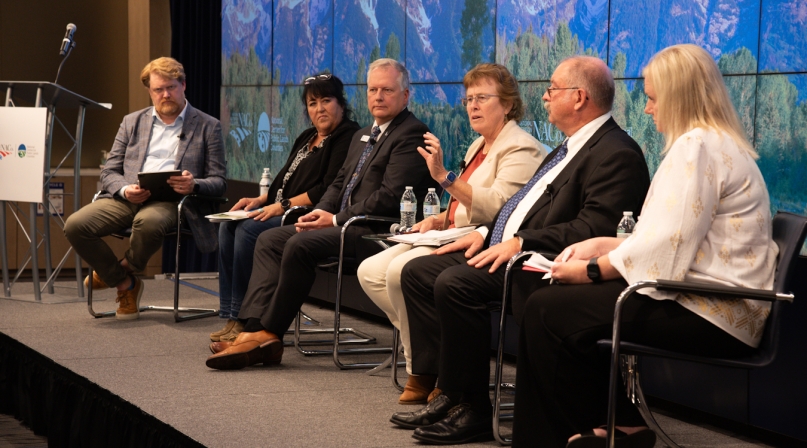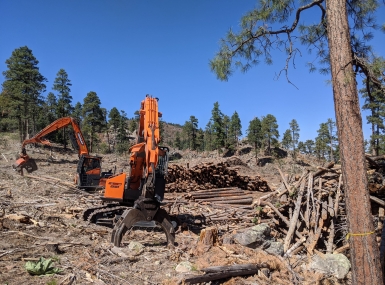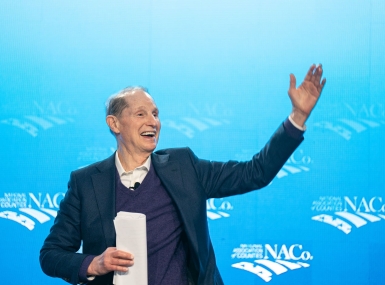Public lands county leaders show vision, experience

Key Takeaways
Following a busy day of Capitol Hill visits by county public lands officials, those leaders offered a sampler of the ideas that could help their peers and the federal government meet their goals.
The inaugural Intergovernmental Forum on Public Lands held Sept. 13 followed a torrid day of visits to members of Congress during NACo’s annual PILT fly-in supporting the Payments in Lieu of Taxes program, and served as a prototype of some of the collected knowledge and experience the National Center for Public Lands aims to aggregate.
Learn more
Counties with significant amounts of publicly owned lands are at the mercy of the federal appropriations process to receive payments through the PILT and Secure Rural Schools (SRS) programs, most of which fills holes in county budgets that include provide services in and around federal lands. The SRS program remains unauthorized.
“A lot of the county officials who have been working on PILT for decades are getting a little long in the tooth,” said Joe Briggs, a Cascade County, Mont. commissioner and NACo’s West Region representative, illustrating the need for resources to limit the loss of knowledge that comes from turnover among county officials.
Capturing the collective knowledge of those officials, along with documents including contracts, agreements, natural resource plans and original research will figure into becoming the go-to resource for public lands counties, who will ensure the center’s independence through its endowment financed by county contributions.
For some ideas like shared stewardship, county commissioners and state and federal forestry personnel drew road maps during the forum for how they broke through bureaucracy and bad habits and set new standards. Despite the millions of acres of U.S. Forest Service land, the agency’s staff is overwhelmed by the magnitude of maintenance required for fire mitigation and infrastructure work. Shared stewardship allows county personnel to work on federal lands, and those agreements have gathered steam since being introduced in the 2018 farm bill.
But Idaho County, Idaho Commissioner Skip Brandt initially blanched when personnel from the Clearwater National Forest approached the county about doing fire mitigation work in the forest for which the U.S. Forest service was understaffed. Though the county already had a program for private lands, the master plan agreement was a nonstarter.
“It was full of Forest Service processes, the same processes that prevent the forester from getting stuff done,” Brandt said. “They were going to require us to have all of our contractors get federal training on how to run a chainsaw.”
The Forest Service relented and let the county name its terms, which produced a participation agreement that fronted the county $200,000 for work the county was able to do in three weeks.
“We still had over half that money left, so they said ‘Well, keep going,’” Brandt said. “By the end of the year, we will have done over $1 million of land treatment for the Forest Service. … we’ve wrapped up everything that they’ve really thought would take us a couple of years to do because if their processes.”
The shared stewardship program is in the eyes of the beholder, according to Mary Farnsworth, the Forest Service Intermountain Region forester.
“Shared stewardship has such a broad framework that there’s not a rule set associated with it, we’ve been able to just get down in the weeds and sort of [explore] ‘What do we want to really affect? And how are we going to do that work?’” she said. “Throughout the country, shared stewardship agreements are different. It’s not one thing, it’s not one definition, there’s not one way of doing it.”
While one size rarely fits all in county government, county officials often borrow from each other and can find inspiration in a kernel of any of the complications counties face. For Duchesne County, Utah, attempts to grow beyond reliance on its oil extraction economy are hindered by the Uintah and Ouray Indian Reservation on nearly one-fifth of its land.
“Because of our isolated nature, we’ve struggled to diversify our economy and really we don’t have a tourism economy,” said Commissioner Greg Miles. “We have to educate visitors to avoid trespass issues, we try to let people know to be respectful of tribal land and we haven’t been able to capitalize on opportunities to share the beauty of our county because you have to cross tribal trust land to get there.”
Public land county leaders often praise the relationships they enjoy with local rangers and officers representing federal land management agencies but notice a distinct disconnect with the federal bureaucracy. That goes for Wyoming Gov. Mark Gordon (R), too.
“We’ve seen a real evolution in land management away from what’s on the ground more and more towards D.C. and D.C. agencies,” he said. “I do believe that folks that are drawn to national service are dedicated, they want to see things happen, they want to do the right thing, but somehow in that effort to try to do the right thing, we’ve paralyzed ourselves.
“I’m going to argue that we need to recalibrate away from these; it is important that we have the sort of national opportunities to work together, but it is very, very important that we have people like yourselves engaged in that process,” he said.
“What’s exciting about what you’re doing today is you’re bringing not only political will and force but practicality through the argument that will make a difference that people will have to listen to.”
Gordon sees potential for counties collectively to operate more efficient regional energy co-ops.
“If you look at what’s happening to large utilities and … the liabilities that are associated with that, I believe we’re at an advent of a kind of a change of how we’re going to do power distribution, and counties are going to be right in the middle of that.”
Related News

Counties search for footing amid federal workforce cuts
Staffing reductions in the federal land management agencies are upsetting the intergovernmental balance in public lands counties.

